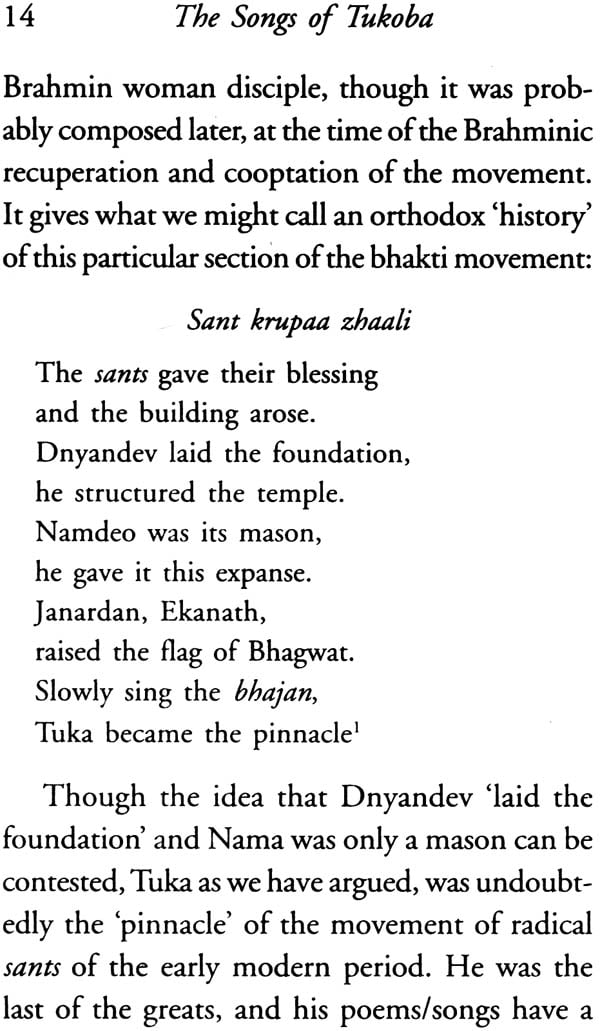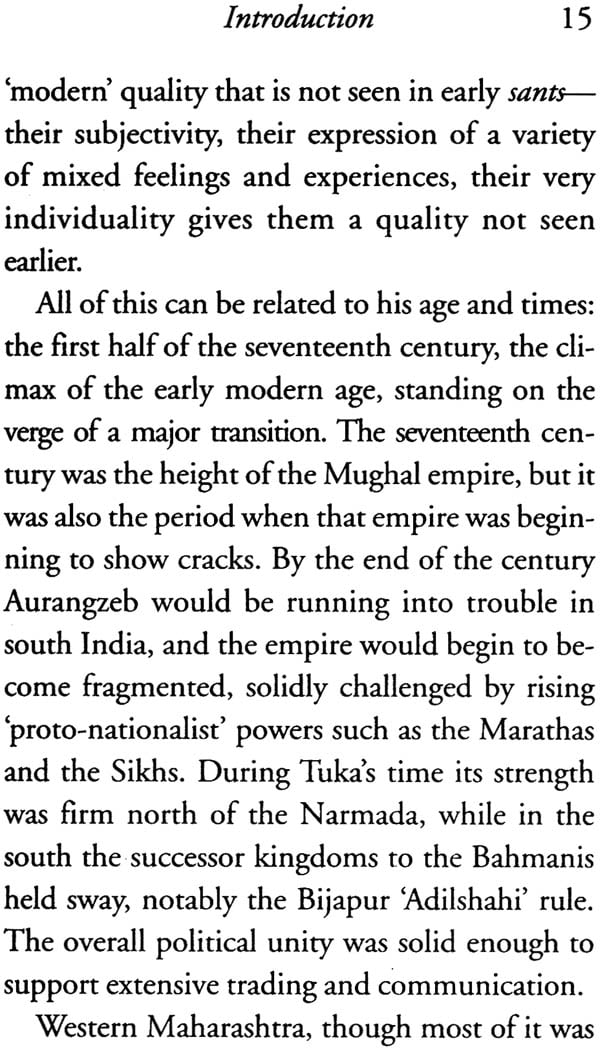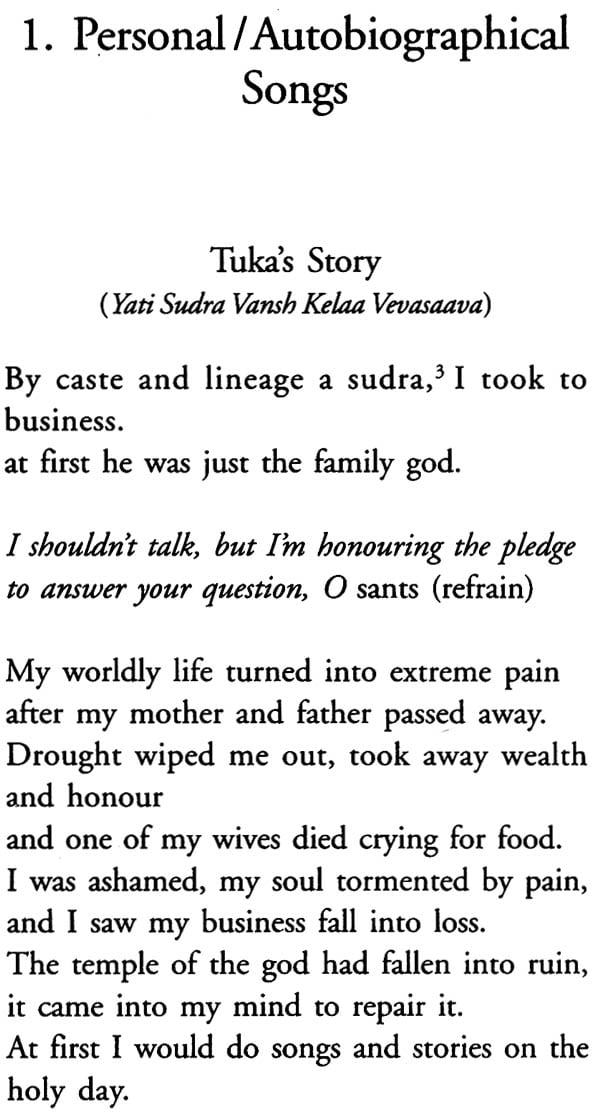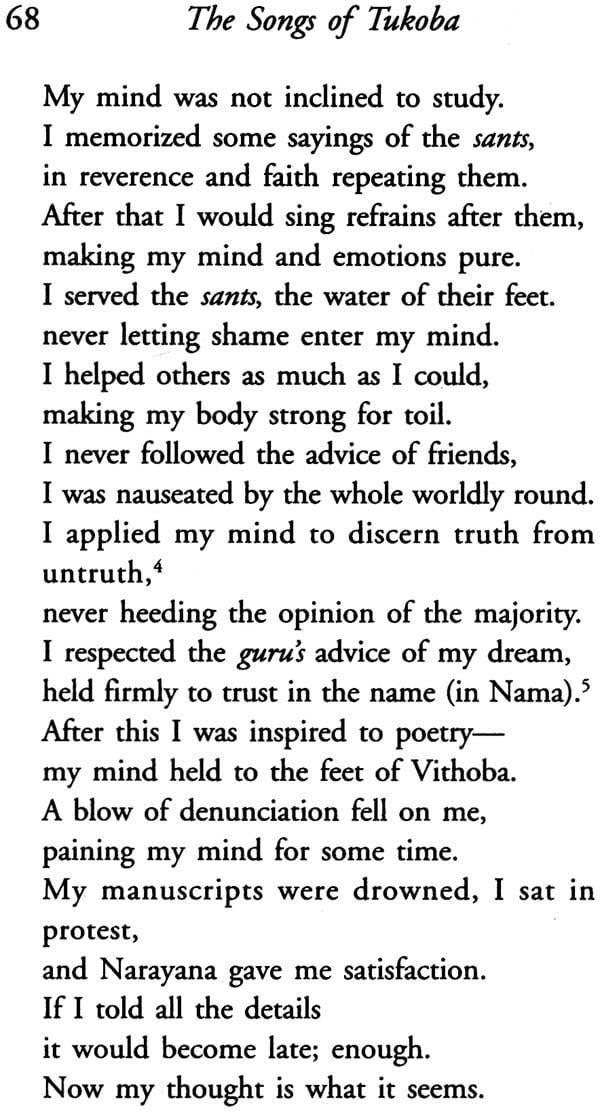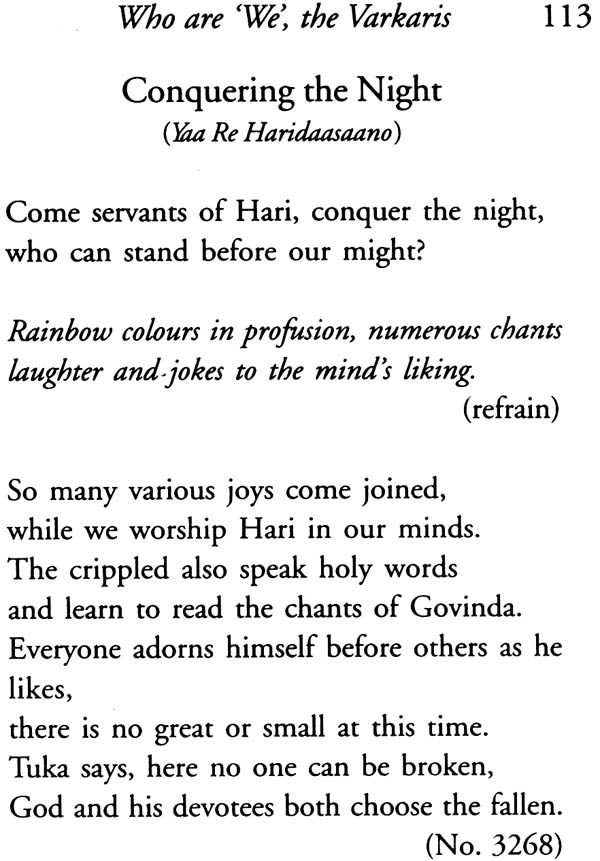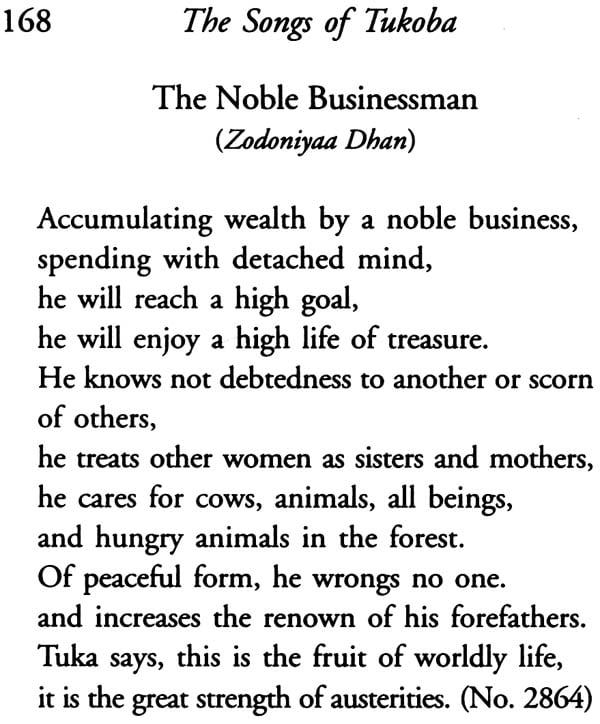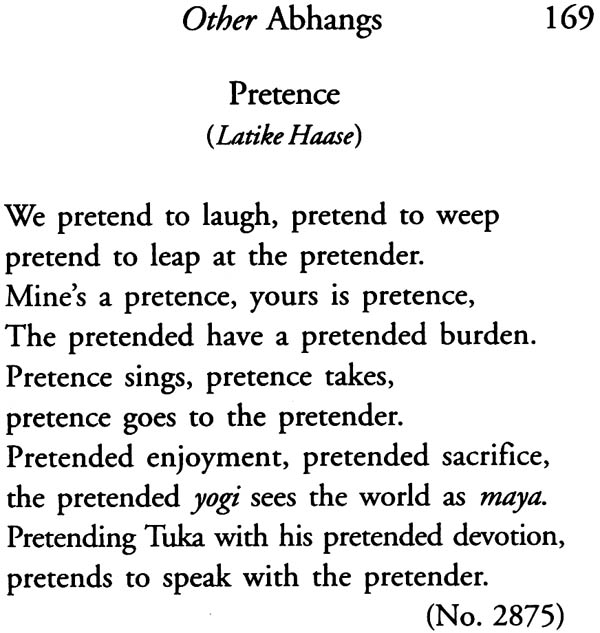
The Songs of Tukoba
Book Specification
| Item Code: | NAF743 |
| Author: | Gail Omvedt and Bharat Patankar |
| Publisher: | Manohar Publishers and Distributors |
| Language: | English |
| Edition: | 2012 |
| ISBN: | 9788173049590 |
| Pages: | 180 |
| Cover: | Hardcover |
| Other Details | 7.5 inch x 5.0 inch |
| Weight | 300 gm |
Book Description
Tukoba (Tukaram) was a seventeenth century Bhakti Sant (saint-poet) of the Varkari movement in Maharashtra. He is still considered the best Marathi poet. These new translations by Gail Omvedt and Bharat Patankar seek to capture the wonder of his writing, his lyricism and his profound meanings.
Gail Omvedt
A renowned scholar, Gail Omvedt has held several senior positions at various universities, the last one being Chair Professor for the Dr. B.R. Ambedkar Chair for Social Change and Development, IGNOU, New Delhi.
She has published widely from different prestigious publishing houses and her most recent work is the revised version of her Ph. D dissertation, Cultural Revolt in a Colonial Society:
Bharat Patnakar
Bharat Patnakar is national president of Shramik Mukti Dal, which is based on the theories of Marx, Phule, Ambedkar, Buddha and works in 11 districts of Maharashtra. He has written numerous books in Marathi on issues of historical material, class and caste, and imperialist globalization, and has published one book of poetry.
lTuka zhales kalas. . .' is the conclusion of a famous song-poem attributed to Bahenabai, his Brahmin disciple. In a sense, Tuka (Tukaram, 1608—49) was the pinnacle of the bhakti move¬ment, not so much because he was the greatest— though his poetry stands with Kabir, Ravidas and others remembered still as the fountainhead of the vernacular literatures—but because he was the last of the greats. After his short life, a period of reaction set in, and the glorious centuries of the devotional movement in India came to an end. Tuka's life embodied much of the vitality, aspi¬ration and struggle common to radical bhakti.
Redical Bhaktir
Beginning in the twelfth century in northern Karnataka, a wave of anti-Brahminical radical devotionalism spread throughout India. In the south it took the form of radical 'Saivism'; in the north and west it was more identified with 'Vaisnavism'. However, its spirit was very different from the co-opted form of bhakti embedded in maths; it was also very critical of—though it shared some features with—the radical 'nath' tradition.
What differentiated 'radical bhakti' from more conservative bhakti? At the level of material social relations, the radicals were men and women who lived as householders (except when they were forced by persecution to leave home and village) rather than 'world renouncers'. They supported themselves normally not by alms but by their own labour; and since the majority of them were drawn from the subordinate castes, from arti-sans, peasants, even labouring groups, this meant by arduous physical toil. When Tuka says in his autobiographical song, that he 'made his body strong for toil', it was this arduous life he was referring to. This idea that people from the 'sudra castes, considered low and fit only for service by orthodox Brahminism, could become 'saints', recognized as holy and as spiritual teachers by the masses, without renouncing household and family, was something new in the Indian trad¬ition. Within Islam, Christianity and Judaism, the great prophets were quite normally house¬holders and family men. Not so in India. Even Buddhism, which had challenged the Brahminic tradition in so many ways, accepted this in only a partial sense in the Mahayana tradition. This continual involvement in the world of life and labour was one that differentiated the radical sants from those who had renounced such a life, who attached themselves to religious maths, ashrams and other institutions. Tuka made a point of this in many of his songs, most notably in No. 272, 'I've not a single fraud to infatuate the world . . . I'm no lord of a hermitage, no habit of holding on to land.
At the level of ideas, the radical bhaktas can be said to have originated a unique form of reli¬gion, one that does not easily fit into what we think of as 'Hinduism'. Some very clearly said that they were 'Neither Hindu nor Muslim', e.g.
Nanak and Kabir. Others simply ignored the whole issue. The Varkaris of Maharashtra, for example, centred their devotion on Vitthal (whom the Brahminic Puranas identified with Vishnu), and often called themselves 'Vishnudas' —butTuka, for example, had included Muslims equally with so-called 'Hindus' as Vishnudas. Clearly, the meanings of terms such as 'Vaisnav-ite', 'Saivite' were different in the medieval-early modern period.
The radical bhaktas challenged, at a very deep level, the Brahminic social system with caste, priestly ritualism and inequality. At the very beginning of the movement, Basava had sponsored an intercaste marriage between a Dalit boy and Brahmin girl; the parents of the couple were brutally executed and in the civil war that followed, the Lingayats were driven from the kingdom of Kalyana; when the movement revived later it was more conservative. But this early period had caught the tone: the Lingayats rejected a temple; posed the linga as simply a symbol; claimed kaya to kailash (the body is heaven) and posed a mantap for discussion and debate to the usual temple worship. Kabir, Nama, Tuka, Ravidas and omers were fervent in their rejection of caste. And, the rejection of ritualism was stark: instead of all the jap-tap, mantra-tantra, etc., what was posed was the 'name'—devotion to God and love for all one's fellow women and men. Kabir puts it strongly in one poem:
Worship, libations, six sacred rites, this dharma's full of ritual blights.
Four ages teaching Gayatri, I ask you, who won liberty?
You wash your body if you touch another, tell me who could be lower than you? Proud of your merit, puffed up with your rights,no good comes out of such great pride
How could he whose very nameis pride-destroyer endure the same?
Drop the limits of caste and clan, seek for freedom's space, destroy the shoot, destroy the seed, seek the unembodied place. (Ramaini 35) (translation based on Hess and Singh in Kabir 1986).
Nama (Namdeo), who probably lived in the thirteenth century, was described by the hagiographer Anantadas as the 'first sunt of the kali-yugd (i.e. of historical times; either the southerners were not known to him or as nominal 'Saivites' they were not considered part of the same movement). He had a number of songs on this theme (of which one is found in almost the same words in Tuka), with the most striking being as follows:
No need of doing vows, austerities, or pilgrimages-Be content with hymns to Hari at home. You don't have to exclude anything of life or food,
Place your every mood at Hari's feet, You don't have to sacrifice, meditate or give up sex;
Your devotion will suffice, laid at Hari's feet. Nama says, hold the name firmly on your tongue,
It will give you a meeting with Pandurang (No. 1371)
It was not only from Brahminism that the bhakti sants differed, it was also from the Nath-Yoga tradition. As Gordon White has shown, most of the Naths or Siddhas were alchemists', using not only Yoga and austerities but also chemi¬cal means (mercury was apparently a favourite) in search of personal immortality. This was not a goai of the sants, who emphasized living life in the 'here and now' and were Jittle concerned with seif A story of AJama, a colleague of Basava, and Gorakhnath symbolizes this difference. When they met, Gorakhnath is supposed to have chal¬lenged AJama to strike him with a sword. When he did so, it smashed to pieces on his 'diamond body'. But when Gorakhnath struck AJama in the reverse challenge, the sword swooped through his body as if it were nothing but air. Such was the 'being' of the sants!
TUKA BECAME THE PINNACLE'
The well-known song that gives Tukaram as the pinnacle' is attributed to Bahinabai, Tuka's Brahmin woman disciple, though it was prob¬ably composed later, at the time of the Brahminic recuperation and cooptation of the movement. It gives what we might call an orthodox 'history' of this particular section of the bhakti movement:
Sunt krupaa zhaali
The sants gave their blessing and the building arose. Dnyandev laid the foundation, he structured the temple. Namdeo was its mason, he gave it this expanse. Janardan, Ekanath, raised the flag of Bhagwat. Slowly sing the bhajan, Tuka became the pinnacle
Though the idea that Dnyandev 'laid the foundation and Nama was only a mason can be contested, Tuka as we have argued, was undoubtedly the 'pinnacle' of the movement of radical sants of the early modern period. He was the last of the greats, and his poems/songs have a ‘modern’ quality that is not seen in early sants- their subjectivity, their expression of a variety of mixed feelings and experiences, their very individuality gives them a quality not seen earlier.
| Introduction: Tuka Became the Pinnacle | 7 | |
| The Songs of Tukoba | 65 | |
| 1 | Personal/Autobiographical Songs | 67 |
| 2 | On Refusing to Meet Shivaji | 85 |
| 3 | Who are 'We', the Varkairs | 88 |
| 4 | Social and Religious Critique | 118 |
| 5 | Religious Questioning | 139 |
| 6 | Other Abhangs | 150 |
| Notes | 176 |
